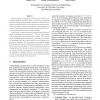Free Online Productivity Tools
i2Speak
i2Symbol
i2OCR
iTex2Img
iWeb2Print
iWeb2Shot
i2Type
iPdf2Split
iPdf2Merge
i2Bopomofo
i2Arabic
i2Style
i2Image
i2PDF
iLatex2Rtf
Sci2ools
HPCA
2005
IEEE
2005
IEEE
Transition Phase Classification and Prediction
Most programs are repetitive, where similar behavior can be seen at different execution times. Proposed on-line systems automatically group these similar intervals of execution into phases, where the intervals in a phase have homogeneous behavior and similar resource requirements. These systems are driven by algorithms that dynamically classify intervals of execution into phases and predict phase changes. In this paper, we examine several improvements to dynamic phase classification and prediction. The first improvement is to appropriately deal with phase transitions. This modification identifies phase transitions for what they are, instead of classifying them into a new phase, which increases phase prediction accuracy. We also describe an adaptive system that dynamically adjusts classification thresholds and splits phases with poor homogeneity. This modification increase the homogeneity of the hardware metrics across the intervals in each phase. We improve phase prediction accuracy b...
Computer Architecture | Dynamic Phase Classification | HPCA 2005 | Modification Identifies Phase | Phase Prediction Accuracy |
| Added | 01 Dec 2009 |
| Updated | 01 Dec 2009 |
| Type | Conference |
| Year | 2005 |
| Where | HPCA |
| Authors | Jeremy Lau, Stefan Schoenmackers, Brad Calder |
Comments (0)

